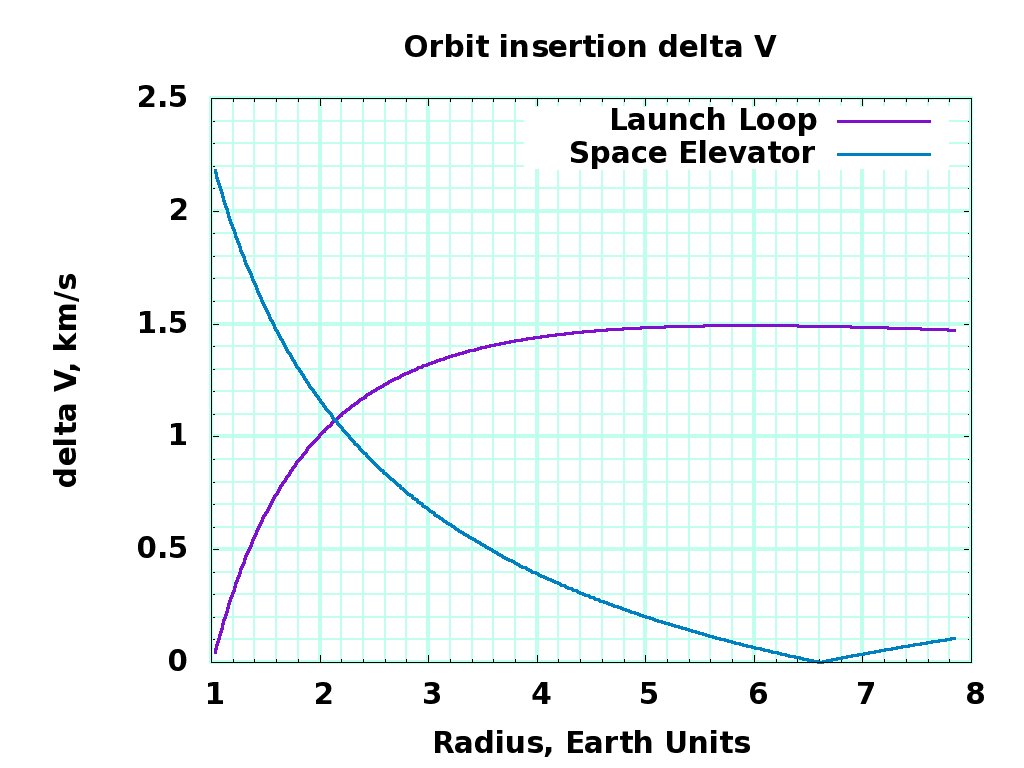|
Size: 3357
Comment:
|
Size: 3395
Comment:
|
| Deletions are marked like this. | Additions are marked like this. |
| Line 8: | Line 8: |
| == Simple Case, Equatorial Orbits == |
Orbit Circularization
What is the ΔV needed for apogee insertion into a circular equatorial orbit from a launch loop transfer orbit, and for perigee insertion from a space elevator transfer orbit?
The destination orbit has a radius of r_d and a velocity of v_d = \sqrt{ \mu / r_d } were \mu = 398600.4418 km3 / s2.
Simple Case, Equatorial Orbits
The launch loop calculation is fairly simple.
An 80 kilometer breech altitude launch loop defines a transfer orbit with a perigee r_p = 6378 + 80 km = 6458 km . The semimajor axis is a = 0.5 * ( r_p + r_d ) , the eccentricity e = ( r_d - r_p ) / ( r_d + r_p ) , the characteristic velocity is v_0 = \sqrt{ \mu / ( a * ( 1 - e^2 ) ) } , and the apogee velocity is v_a = ( 1 - e ) v_0 . Combining and simplifying:
{v_a}^2 = ( 1 - e )^2 {v_0}^2 = ( \mu / a ) ( 1 - e )^2 / ( 1 - e^2 )
{v_a}^2 = ( 2 \mu r_p ) / ( r_d ( r_d + r_p ) )
v_a = \sqrt{ ( 2 \mu r_p ) / ( r_d ( r_d + r_p ) ) }
\Delta V = v_d - v_a
The space elevator calculation is more complicated.
For transfer orbits below geosynchronous, the apogee of the orbit is the release radius r_a , and the angular velocity is \omega_E = 2 \pi / P_{sidereal} , where P_{sidereal} is the sidereal day, 86164.0905 seconds. We want to find r_a and the perigee velocity v_p . We will have to work backwards.
v_a = \omega_E r_a
{v_a}^2 / 2 \mu = 1 / r_a - 1 / ( r_a + r_p )
Solve for r_p , perigee radius, the candidate r_d
r_p = \Large { r_a \over { \Large { { \huge { 2 \mu } \over { {r_a}^3 {\omega_E}^2 } } } - 1 } }
Testing empirically with a spreadsheet:
r_a |
r_p |
|
29 000 |
5 634 |
smash! |
29 790 |
6 378 |
earth surface |
30 000 |
6 678 |
300km altitude |
34 383 |
12 789 |
M288 |
39 267 |
26 600 |
GPS |
42 164 |
42 164 |
GEO |
50 964 |
384 400 |
Moon |
53 120 |
inf |
Escape |
So, a 20 iteration binary search of r_a between 29700 km and 53000 km will converge r_p on our target r_d
The numbers are approximate; the space elevator will not stay perfectly vertical, but will swing back and forth. Lunar and solar tides will displace the counterweight, payload releases will change the altitude of the tether, etc.
Delta V Comparison
Launch Loop payloads need less \Delta V up to 2 R_e radius ( 1 R_e altitude ). The space elevator wins above 2.5 R_e radius.
source code . . . gnuplot control file
Interestingly, the \Delta V 's at 2 R_e are 13% of the earth launch velocity to that altitude, about 1100 m/s, and are in opposite directions for the two systems. Conceivably, a tether system strung vertically between two counterweights could make an orbiting "landing pad" at 2 R_e , with payloads travelling down from the space elevator slowing down on this tether, and payloads from the launch loop speeding up on it. The two systems working in tandem may both supply mass to this station, with little or no rocket reaction mass needed.

